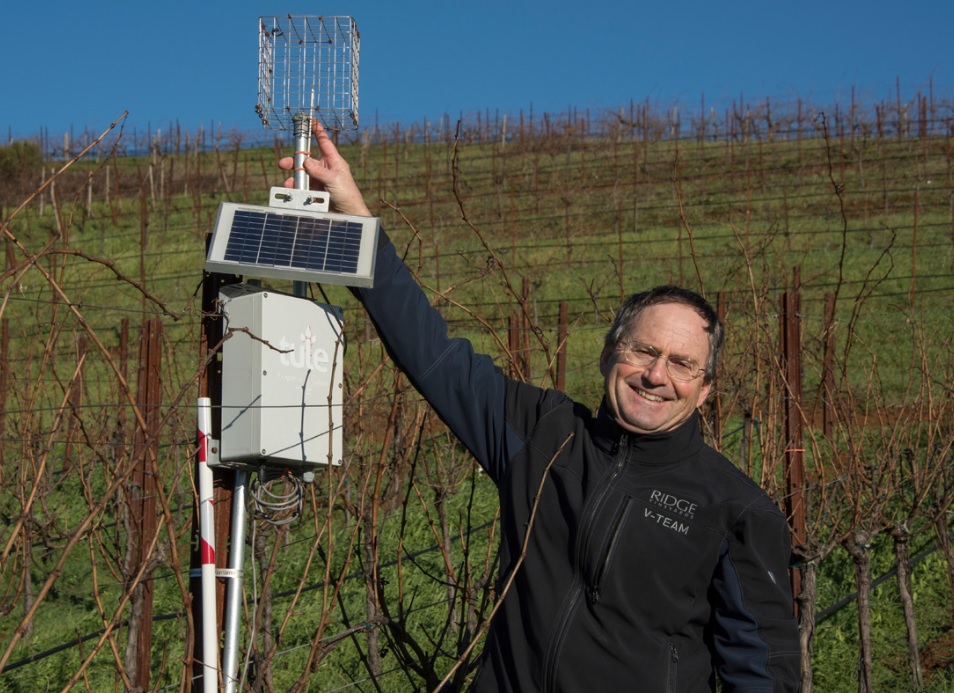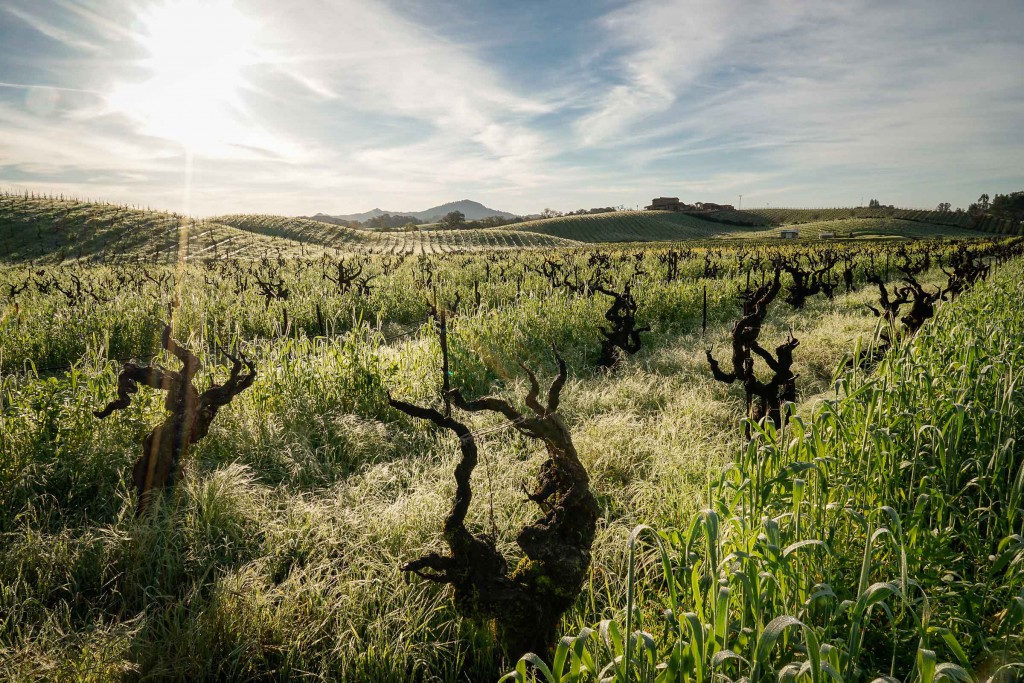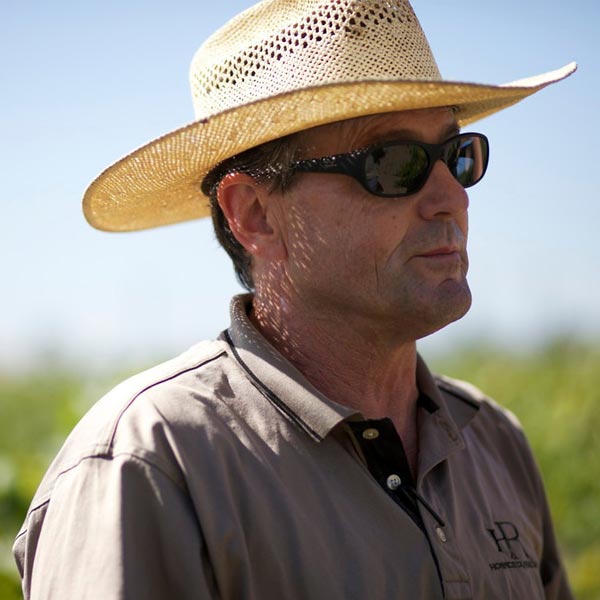Ridge Trims Water Use with Technology
Blog Post
The California Sustainable Winegrowing Alliance checks in with our Senior Vice President of Vineyard Operations, David Gates on the ways we are using technology to save water. The feature was part of the CSWA’s Down to Earth Newsletter, a monthly newsletter celebrating the commitment of California vintners and growers to sustainable winegrowing and winemaking.

New Ways to Save Water
Even if several rainy years moderate California’s drought, grape growers know that wise water use remains a priority. Water-wise farming is the new normal, and progressive vineyard managers are exploiting technology to make smarter irrigation choices. At Ridge Vineyards in the Santa Cruz Mountains, Senior Vice President of Vineyard Operations David Gates, Jr., has implemented two promising new methods for water management.
You are using some new vineyard technologies to fine-tune water use. Can you describe them in layman’s terms?
The sap-flow sensor is a sleeve that goes over a small-diameter piece of the vine, such as a cane. The sleeve has two temperature sensors in it and a heater between them. You heat the sap flowing in the vine and measure the temperature difference in the sap before the heat and after. If you know the diameter of what you’re measuring, an equation can tell you the rate of sap flow. You compare that to the vapor-pressure deficit—basically, the atmospheric conditions that are driving photosynthesis, like temperature, humidity and wind. That deficit number is important because it represents the demand on the vine. This Fruition Science technology has helped to both improve the timing of our irrigations and to reduce the total amount of water we use.
We use another vapor-pressure deficit technology in the vineyard. The difference is that the Tule Technologies places sensors above the vine canopy at different heights, and through technology developed by the owner, these sensors can tell you how much the block is transpiring. With both systems, you’re basically comparing how much the vine is transpiring given the atmospheric demand. As long as the vine can respond to the demand, it doesn’t need water. Sensor data helps determine vineyard water needs.

How were you making watering decisions in the past?
I was basing it on my experience and the weather. I’ve been farming here since 1989. But I was overwatering, especially on the mature vines. It’s a farmer thing: you want to sleep better at night. If you’re a little worried, it never hurts to water… but it doesn’t help either. Those were irrigations that didn’t need to happen.
How has this high-tech information affected your water use?
In the past, I would water older vines right before harvest although I was never sure they needed it. Six years ago, I put sensors on the vines, and I managed the vineyard as I typically do. Ten days before picking, I gave the block a deep irrigation and the sensors didn’t really change. Typically, if vines need water and you give it to them, they respire quite a bit and you get a big bump in response. We didn’t see that, which means they didn’t need irrigation.
My philosophy has always been: long, deep irrigation only when needed. We’re trying to mimic rain. We’re now doing fewer irrigations per year. Mature vines in our best soils don’t need any supplemental water; before, we had been irrigating once in a normal year, maybe twice in a drought year. On young vines, instead of five or six irrigations, we’re doing three or four.
Can you quantify how much water you’re saving?
We use zero water at our Monte Bello vineyard up to about 50 gallons per vine per year elsewhere. That’s about half the amount we were using when we installed the sensors.
Any impact on wine quality?
No impact on quality… or quantity either. We haven’t seen an increase in quality, but I’m happy with our quality as it is. The technology has made us better able to manage a precious resource.
Can you use these technologies to manage canopy growth?
Yes, you can. In the Central Coast or San Joaquin Valley, where you have limited soil moisture in spring because of sandy soils or low rainfall, you can use the technology to design the canopy you want–maybe a canopy that’s not so big. The North Coast is different because, in a typical year, we start the growing season with plenty of available water and it’s hard to slow the vines down.

So now you know how much water the vine is using, but how much stress is the right amount for quality winegrapes?
That’s the big question. If you give vines water, they will grow. The best sites have a soil type and/or climate that helps limit growth. You only need three to four feet of shoot growth to properly ripen fruit, so stress is good, but overstress can lead to undesirable flavors. If you’re on the valley floor with deeper soils and more water, you can use this technology to stress the vines a little more or less and see what maximizes fruit quality.
Do you think you can lower water use any further?
Having both systems on a young block will give me information that I can use with other young blocks as they mature. Young vines are goofy. They can grow well one year and not so well the next, produce tremendous quality one year and so-so grapes the next. It can take 10 to 12 years for a new vineyard to settle down. If I can accelerate that process through better-monitored irrigation, it will add to our bottom line.
How do these vineyard technologies jibe with Ridge’s winemaking philosophy?
We use technology to make sure we’re interfering as little as possible. In the winery, we do a lot of analysis so that we only have to step in when necessary. We use technology not to manipulate the grapes, but to manipulate them less. The more you manipulate, the less site-specificity you find in the grapes or the wines, and we’re all about making wine from sites that we find unique and interesting.
Copyright Wine Institute
Wait!
In order to qualify for user related discounts, you must log in before proceeding with checkout. Click the button below to log in and receive these benefits, or close the window to continue.
Log In